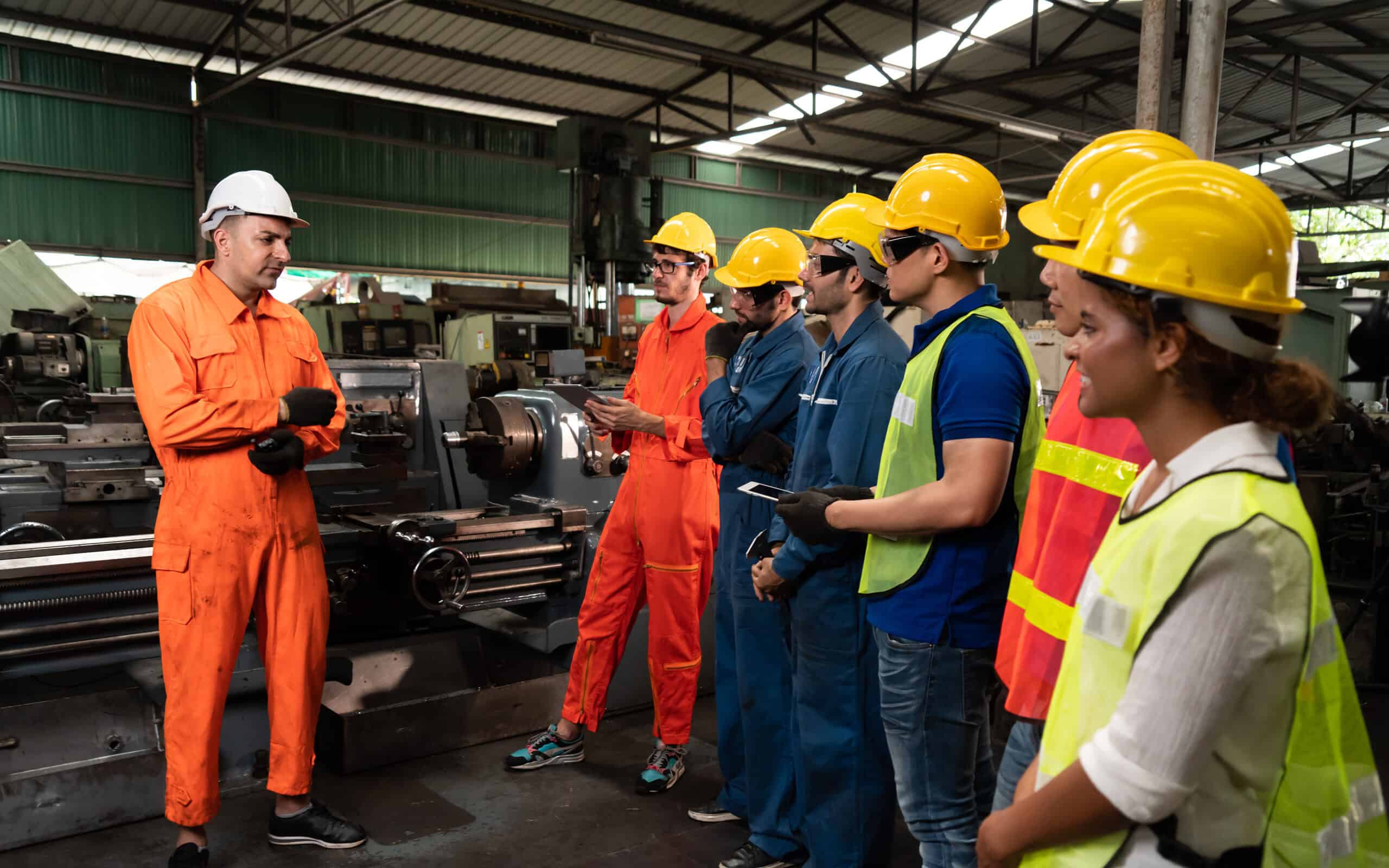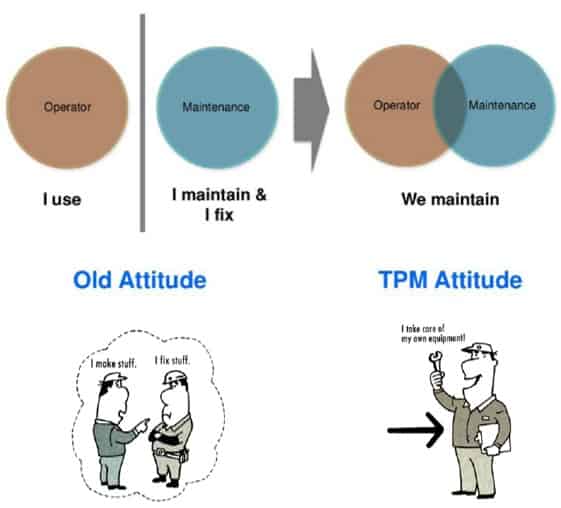
If your machines are not working, you can’t produce products for your customers. Your customers will likely not remain your customers for very long. Let’s see how Total Productive Maintenance (TPM) can keep your equipment up and running.
Total Productive Maintenance (TPM) is a maintenance strategy aimed at maximizing the productivity of equipment, machines, and processes through the involvement of all employees in their maintenance and improvement. The goal of TPM is to minimize downtime, improve equipment reliability and quality, reduce costs, and enhance the overall safety and work environment. TPM focuses on proactive and preventative maintenance, regular inspections, and employee involvement in maintenance activities, to achieve maximum equipment efficiency and overall productivity.
Overview: What is TPM?
The history of Total Productive Maintenance (TPM) dates to the late 1950s and early 1960s in Japan. It was developed by the Japanese Institute of Plant Maintenance (JIPM) as a response to the need for a more efficient and effective approach to maintenance.
TPM was initially developed for use in the manufacturing industry, but it quickly spread to other sectors, including service industries, healthcare, and government organizations. The success of TPM in Japan led to its widespread adoption globally, and today it is used in many countries worldwide. TPM was first introduced to the West in the late 1980s, and it has since become an established maintenance strategy, with many organizations implementing TPM to improve the productivity of their equipment and processes.
The basic principles of TPM have remained unchanged over the years, but the focus has shifted from purely equipment-based maintenance to a broader approach that includes process improvement, employee involvement, and continuous improvement. Today, TPM is recognized as a best practice for maximizing equipment and process efficiency, reducing costs, and improving quality.
To implement TPM there must be a paradigm shift in how your organization views maintenance. Below is a simple graphic showing the needed shift.

While there are several graphics which summarize the pillars of TPM, the one below captures the goals, activities, and foundation:

Note that the 3 goals of TPM are: zero accidents, zero defects, and zero failures. The foundation is the classical 5S plus Safety.
5 benefits of TPM
Total Productive Maintenance (TPM) offers several benefits, including:
1. Increased equipment efficiency and reliability
TPM focuses on proactive and preventative maintenance, which helps to minimize downtime and increase the efficiency and reliability of equipment.
2. Improved quality
TPM helps to identify and eliminate the root causes of defects and quality problems, leading to improved product quality.
3. Lower maintenance costs
By reducing downtime and increasing equipment efficiency, TPM helps to lower maintenance costs.
4. Enhanced safety
TPM emphasizes the importance of safety in maintenance activities and promotes a safe work environment.
5. Employee involvement
TPM involves all employees in the maintenance and improvement of equipment, which can increase job satisfaction and motivation.
Why is TPM important to understand?
There are several reasons why it is important that you understand TPM. They are:
TPM requires a paradigm shift in thinking
Traditionally, maintenance was performed by maintenance workers as a reactive activity. TPM uses planned and proactive maintenance activities done both by maintenance workers as well as the operators who run the equipment.
The foundation of TPM is 5S+1
The implementation of a 5S+1 program in your organization will serve as the foundation of TPM. Having a clean and safe work environment is the basis for effective maintenance of your equipment.
It’s not just about the equipment
There is a large human component associated with TPM. This would include safety, health, and environmental issues (SHE). SHE activities aim to eliminate the root causes of incidents that have occurred, to prevent reoccurrence, and proactively reduce the risk of future potential incidents by targeting near misses and potential hazards. The SHE elements target three key areas: people’s behaviors, machine conditions and the management system.
An industry example of TPM
The company had implemented a focused 5S+1 program as the foundation for its goal of implementing TPM. Given the success of the 5S+1 program the VP of Manufacturing decided it was time to move to the next two steps. He chose to start working on Autonomous Maintenance and Planned Maintenance. They are defined as:
- Autonomous maintenance refers to activities designed to involve operators in maintaining their own equipment, independent of the maintenance department.
- Planned maintenance is a scheduled service visit to ensure that equipment is operating correctly and to avoid any unscheduled breakdown and downtime.
After the necessary training and creation of appropriate processes, the company was able to reduce its unscheduled downtime by 48% and reduced maintenance costs by 39%.
7 best practices when thinking about TPM
Here are some best practices for implementing Total Productive Maintenance (TPM) in your organization:
1. Involve all employees
TPM involves all employees in the maintenance and improvement of equipment, so it’s essential to engage operators, maintenance personnel, and management in the TPM process.
2. Conduct a TPM assessment
A TPM assessment helps to identify areas for improvement and sets the foundation for a successful TPM implementation.
3. Set clear TPM objectives
Establish clear and measurable TPM objectives to guide the implementation process and monitor progress.
4. Develop a TPM plan
Create a detailed TPM plan that outlines the steps to be taken to achieve the TPM objectives.
5. Promote a safe work environment
Safety should be a top priority in all TPM activities, so it’s essential to provide training and resources to ensure a safe work environment.
6. Implement a visual management system
A visual control and visual management system helps to communicate TPM information and progress to all employees, so it’s essential to establish a system for tracking and displaying TPM metrics.
7. Encourage employee participation
Encouraging employee participation in TPM activities is essential for success, so it’s important to recognize and reward employees for their contributions to the TPM process.
Frequently Asked Questions (FAQ) about TPM
Here are some frequently asked questions about Total Productive Maintenance (TPM):
What does TPM stand for?
TPM stands for Total Productive Maintenance.
What is the purpose of TPM?
The purpose of TPM is to maximize the productivity of equipment, machines, and processes through the involvement of all employees in their maintenance and improvement.
What are the key principles of TPM?
The key principles of TPM include proactive and preventative maintenance, regular inspections, employee involvement, and continuous improvement.
How does TPM differ from traditional maintenance?
TPM differs from traditional maintenance in that it involves all employees in the maintenance and improvement of equipment and focuses on proactive and preventative maintenance. Traditional maintenance is often reactive and performed by maintenance personnel only.
Revisiting TPM
In industry, Total Productive Maintenance (TPM) is a system of maintaining and improving the integrity of production and quality systems through the machines, equipment, processes, and employees that add business value to an organization. TPM focuses on keeping all equipment in top working condition to avoid breakdowns and delays in manufacturing processes.